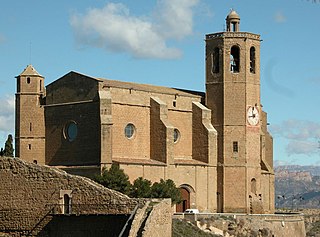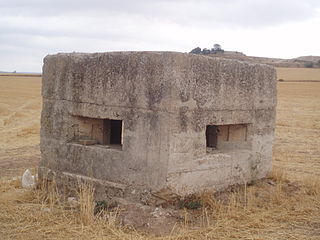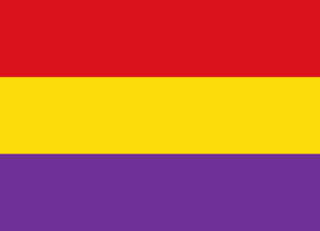
Balaguer is the capital of the comarca of Noguera, in the province of Lleida, Catalonia, Spain. It is located by the river Segre, a tributary to the Ebro. The municipality includes an exclave to the east. Balaguer also has a sister city in the western United States, Pacifica, California.
The Battle of Albarracín took place in Albarracín and surrounding areas (Teruel) between 5 July and 11 August 1937, during the Spanish Civil War.

The Battle of Segre is the collective name of a series of battles that took place along the Segre River between 4 April 1938 and 3 January 1939 during the Spanish Civil War, after the Nationalist Faction had broken the lines of the Spanish Republican Army in the Aragon Offensive.
The siege of Gandesa took place between July and November 1938 during the Spanish Civil War, a few months after a battle in the same town.

The 224th Mixed Brigade was a mixed brigade of the Spanish Republican Army in the Spanish Civil War. It was formed in summer 1937 in Catalonia from scattered Coastal Defence units and had four battalions: the 893, 894, 895 and 896.

The Eastern Region Army Group, Spanish: Grupo de Ejércitos de la Región Oriental (GERO), was a military formation of the Spanish Republican Army during the last phase of the Spanish Civil War. It was established in June 1938 as a response to the splitting in two of the territory under the sovereignty of the Spanish Republic after the Central Region Army Group (GERC), under the command of General Miaja, had been set up in the central-southern region of Spain.

The 26th Division was a division of the Spanish Republican Army in the Spanish Civil War. It was formed in April 1937 in Aragon from the militarized Columna Durruti during the reorganization of the Spanish Republican Armed Forces.

The 11th Division was a division of the Spanish Republican Army in the Spanish Civil War. It was formed in January 1937 in Madrid beginning with the 1st Mixed Brigade which in turn had originated in the Fifth Regiment.

The 3rd Mixed Brigade, was one of the earliest mixed brigades of the Spanish Republican Army in the Spanish Civil War. It was formed in the fall of 1936 with battalions of the Carabineros corps and saw major action right away in the Defence of Madrid. This brigade also included female combatants —such as Sergeant "La Chata"— and would take part in most of the major battles of the Spanish Civil War, except in the Battle of Jarama.

The 84th Mixed Brigade, was a mixed brigade of the Spanish Republican Army in the Spanish Civil War. It was formed in March 1937 with battalions of the Iron Column and was disbanded after the tragic events at Mora de Rubielos when 46 soldiers were shot by firing squad in a decimation following the brigade's Battle of Teruel December combats in harsh winter conditions.
The Eastern Army, also translated as the Army of the East, was a unit of the Spanish Republican Army that operated in the eastern part of Spain during the Spanish Civil War. Republican forces deployed on the Aragon front of the war initially came under the command structure of the unit. Later in the Civil War, the unit operated in Catalonia, defending the Republican defensive line along the Segre river.
The 94th Mixed Brigade was a unit of the Spanish Republican Army created during the Spanish Civil War. It came to operate on the Teruel, Aragon and Segre fronts.
The 24th Division was one of the divisions of the Spanish Republican Army that were organized during the Spanish Civil War on the basis of mixed brigades. Throughout the war, the unit was deployed on the Andalusian, Madrid, Aragon and Segre fronts, taking part in some of the main battles.
The 16th Division was one of the divisions of the Spanish Republican Army that were organized during the Spanish Civil War on the basis of the Mixed Brigades. It had an outstanding participation in the Battle of the Ebro.
The 95th Mixed Brigade was a unit of the Spanish Republican Army that took part in the Spanish Civil War. Throughout the war, various brigades came to use the number "95", operating on various fronts.
The 140th Mixed Brigade was a unit of the Spanish Republican Army created during the Spanish Civil War. Throughout the war it operated on the fronts of Aragon, Segre, Ebro and Catalonia.
The 72nd Division was one of the divisions of the Spanish Republican Army that were organized during the Spanish Civil War on the basis of the Mixed Brigades. It was present on the Aragón and Segre fronts.
The 141st Mixed Brigade was a unit of the Spanish Republican Army during the Spanish Civil War. It participated in the Battle of Belchite, Aragon Offensive, Battle of the Segre and the Catalonia Offensive.
The XII Army Corps was a military formation belonging to the Spanish Republican Army that fought during the Spanish Civil War. Formed by veteran units, throughout the war it took part in prominent intervention in some of the main battles of the war, such as Aragon or the Ebro.
The 145th Mixed Brigade was a unit of the Spanish Republican Army created during the Spanish Civil War. Throughout the war, it operated on the Aragon, Segre and Catalonia fronts, although it did not play a relevant role.







